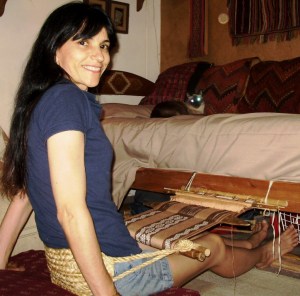|
Neither of these!
Its the backstrap
loom, in its many incarnations.
Found from Southern America through to Central Asia and beyond, weavers
are still producing complex and exciting cloth from this simplest of tools.
Its small, does not
require expensive or extensive equipment, and can be set up and taken down in a matter of minutes, and rolled up with the
work still on it.
Not only that! Even in the hands of a novice, intricate designs and patterns can be woven that are
almost impossible to reproduce on a modern 4 shaft loom, without a great deal of time and energy. The fabric can be as wide
or as narrow as you want - the only limitation is how wide you can stretch your arms, and even this is not a handicap in Thailand,
and Indonesia, and other South East Asian countries where these looms are still very much part of the weaving scene today.

|
| Laverne Waddington and cat busy weaving! |
I am not going to duplicate the work of others, but refer you
on to some excellent resources for learning how to use one of these looms written by an expert on the subject, Laverne Waddington,
who lives in Bolivia.
A good introductory class can be found at Weavezine, and includes everything you will need to make
one of these looms:
This will give you a taste of what she has to offer as a teacher,
and she gives weekly
updates to her weaving blog here:
Lavernes' e-book on Andean Pebble Weave on Weavezine
is well worth purchasing as she covers far more than she has published
elsewhere. She explains several different warping techniques, and provides original patterns of increasing complexity to build
up your skills.
You can also find more information, and Laverne's basic tutorials by joining Weavolution, the free social networking
community for weavers:
and for those who are on dial-up, or have a download limit, there is the Yahoo backstrap group:
However, if, like me, you are not keen on the idea of sitting on the ground to do your weaving, there are alternatives
that can make quite a wide variety of fabrics, without busting the budget, or getting so complicated that you require a wood-working
degree. One end rests your knee while you work, while the other end rests against a table, or something thats slightly higher
than knee level.
These looms are found along side the backstrap looms, and like the backstrap they generally pack
away when not in use.
Which makes
some of them ideal for our modern lifestyles too.
I would suggest a quick side-trip
at this stage to one of my very favourite sites about weaving. Marla Mallet is not only an expert on tribal rugs, but
she is also a weaver, and has written a fascinating book on the subject. You will find a wealth of information about tribal
textiles on her site, and its full of fabulous photos. She also gives instructions for building a very simple frame loom and
how to start weaving on it:
and those who prefer a simple and effective loom with a built in tensioning device, please follow this link to the
the Mapuche/Toba Loom
|
